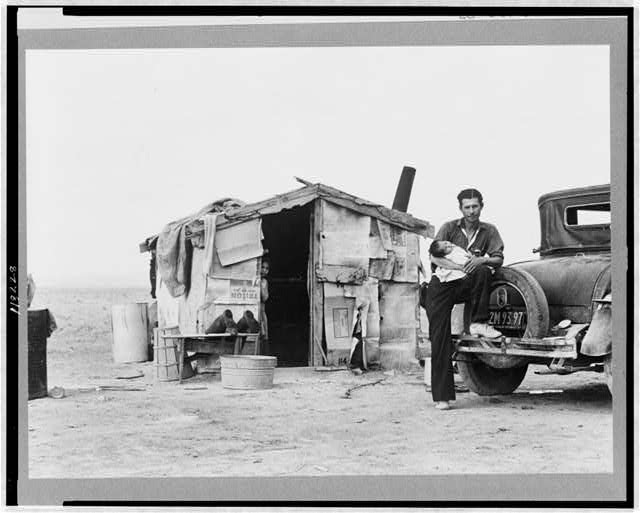
1937 “ Migrant Mexican Children in Contractor's Camp at Time of Early Pea Harvest ”
Photograph by Dorothea Lange
History
Home | Education | Healthcare | History | Migratory Patterns
Law & Activism | Bibliography | Image Gallery
“We depend on misfortune to build up our force of migratory workers and when the supply is low because there is not enough misfortune at home, we rely on misfortune abroad to replenish the supply.” ~President Harry S. Truman, 1951 (27)

1937 “ Migrant Mexican Children in Contractor's Camp at Time of Early Pea Harvest ”
Photograph by Dorothea Lange
Farm workers and their families are often the forgotten face of the agricultural industry. Two to four million women, men, and children are exposed to harsh and grueling conditions everyday for minimal wages. (28) Along with undesirable working conditions, migrant workers also face economic, health, and living hardships that bring adverse affects to their lives (29). When looking at the experiences of migrant workers it is important to also review the history of these people. Without examining the history of such an important part of today's society an integral piece of America's past is lost. In addition to remembering the history of migrant workers it is necessary to look to the present condition of these workers to compare the differing times. Through the contrast of the origination of migrant farm work and the present conditions one can gain an understanding of what the future holds for these people who make agricultural business in the United States what it is today.
Through the examination of the history of migrant farm workers an important insight into the past of the United States can be gained. Early in the history of America small family farms comprised the majority of agricultural labor; however, throughout the last century technology and big business have advanced agricultural production. New machines for harvesting crops, more productive methods for fertilization, and more concise forms of production led to a drastic increase in the volume of agricultural goods produced. All of these advancements caused small family farms to be driven out of business because an increase in the volume of goods drove the cost of produce down so small farms were not able to compete with this new “agribusiness” controlling the agricultural market. Not all produce can be processed by these new technologies because many items harvested, such as fruit and vegetable crops, bruise easily when not handled gently. Many farms have drastically grown in size in order to produce enough goods to make a profit. Many farms, in response to the growth of agricultural production, do not have enough workers in the family to help with the harvest. This demand for low-wage labor caused the need for large groups of mobile workers to radically increase (30).
Migrant workers eventually became the solution to providing low cost labor to owners of large agricultural farms. Migrant farm workers appeal to farm owners because of their non-mobile status along with their ability to provide the necessary services for specific periods of time. Farm workers provide services for limited amounts of time for low wages; however, the down side to this is minorities, oppressed people, and those of lower economic class standing have been the laborers farm work since the beginning of “agribusiness” (31). Agricultural goods in the United States are kept at lower costs to consumers because of the use of migrant workers while the majority of countries in other parts of the world pay prices two to three times higher than those in this country. Migrant workers are an integral part of society in America; however, their presence within the U.S. is not often recognized or considered (32).
Though the past history of migrant labor is important to consider it is also necessary to examine the present in order to thoroughly understand the conditions of migrant workers in this country. Migrant work may seem like a thing of the past to some people; however, migrant work is still a very important component to the functioning of the agricultural industry. Studies show that 65% of migrant workers still travel to obtain work, which includes travel to all portions of the country (33). Many migrant workers experience poor living conditions, in addition to economic insecurity, due to the constant movement of the majority of migrant workers (34). Furthermore, the majority of migrant workers are originally from Spanish speaking countries (previously the majority of agricultural laborers were of African decent) and a language barrier is created as these people attempt to temporary integrate into local communities (35,36). In recent years alterations in the pattern of migration by workers has been by the increasing specialization of farms and advanced technology that is capable of handling more fragile produce (37). These changes continue to affect the lives and patterns of living for migrant workers with in the United States.
The history of migrant workers has shown to be an integral part of American history. Through the comparison of past experiences of migrant farm workers to those of the present one can see how technology has affected the patterns of migration and the experiences of these farm workers. Technology will most likely continue to affect the patterns of migration and conditions of migrant farm worker life; however, for the time being migrant workers will be a necessity to the agricultural business of this country. Migrant workers continue to hold agricultural prices down due to their acceptance of low wages. By examining the history of migrant workers it is easy to see that without migrant workers the true dependence of the American people on low cost labor workers would be realized.